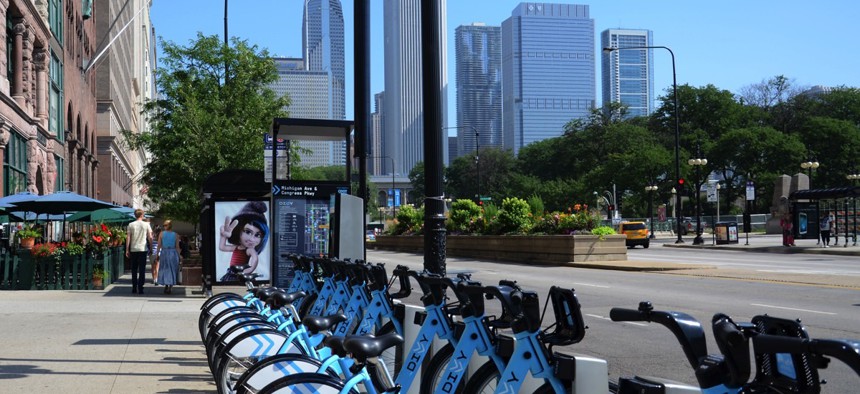Minority Neighborhoods Benefit From Shared Mobility Systems

A Divvy bikeshare station on Michigan Avenue in Chicago, Illinois.
Chicago is expanding its bikeshare program into disadvantaged communities, increasing cost-effective access to jobs and educational opportunities.
Cities looking to expand shared mobility to disadvantaged communities have a few new mapping and policy tools at their disposal, courtesy of the Shared-Use Mobility Center.
Bikesharing, carsharing and ridesharing can fill transportation gaps where other options are lacking, so the Chicago-based, public-interest organization began collaborating with 27 North American cities in the Urban Sustainability Directors Network to provide an interactive mobility toolkit.
In Chicago, SUMC’s opportunity analysis model shows 38 percent of low-income, minority neighborhoods—those more than 50 percent non-white and Latino—can support shared mobility and access carsharing or bikesharing. That’s compared to 67 percent of low-income, non-minority neighborhoods—more than 50 percent white.
“We’re really trying to show that these kinds of services can work in a wide variety of places,” Sharon Feigon, SUMC’s executive director, said in an interview. “Our vision is a transportation system that connects all the different modes, where transit is the backbone and shared mobility is the first and last mile and filling in the gaps.”
The mapping tool also shows many disadvantaged urban neighborhoods lacking shared mobility access can still support such systems because of their high population density, nearby transit and walkability.
SUMC’s tool works by mapping shared mobility vehicle locations in more than 50 cities to visualize regional infrastructure and couples that with census data and transit quality information to highlight service disparities, as well as ideal modes.
A benefits calculator lets cities model shared mobility growth scenarios to gauge greenhouse gas emissions, vehicle miles traveled and cost savings. The third tool, a policy database, holds more than 700 shared mobility laws, studies and strategic plans to inform future regulations.
Chicago is making headway promoting shared mobility in the last year with its Divvy for Everyone program, helping residents facing financial hardship access its bikeshare program—one of the nation’s largest. Divvy started downtown and in core neighborhoods, and by expanding the system and offering discounted memberships the city hopes to bring healthy, inexpensive transportation to outlying areas.
There’s also the added benefit of reducing public reliance on private vehicles.
“Single-occupancy autos are the most expensive way to get around, they’re depreciating assets and 95 percent of the time we see them sitting in cities,” Feigon said.
With the advent of freeways, many jobs moved from city centers to their outskirts decades ago making them less accessible.
Complicating matters further, in recent years Chicago has seen many companies return downtown.
“Some companies are coming coming back, and that access is terrific, but there’s still a big gap in communities being able to get to those locations,” Feigon said.
Shared mobility reduces household transportation costs, connects people to jobs and educational opportunities outside their typical sphere, and lessens traffic congestion—as has been the case in Los Angeles.
“Through the USDN network, we were able to use SUMC's Opportunity Analysis tool to help design and evaluate opportunities to expand our EV carsharing pilot in disadvantaged neighborhoods where both need and shared mobility opportunity are high,” said Susana Reyes, a senior policy analyst for Los Angeles Mayor Eric Garcetti, in a statement. “We look forward to continued use of the toolkit as we plan for future transportation developments in the region.”
SUMC’s toolkit is free for now, though the organization is considering how it might price it in the future.
Currently more than 400 North American cities have carsharing, 75 bikesharing and 1800 ridesharing, according to SUMC. For a detailed look at those numbers with case studies, check out their full report.
Dave Nyczepir is a News Editor at Government Executive’s Route Fifty and is based in Washington D.C.

NEXT STORY: Millennials Bring New Life to Some Rust Belt Cities






